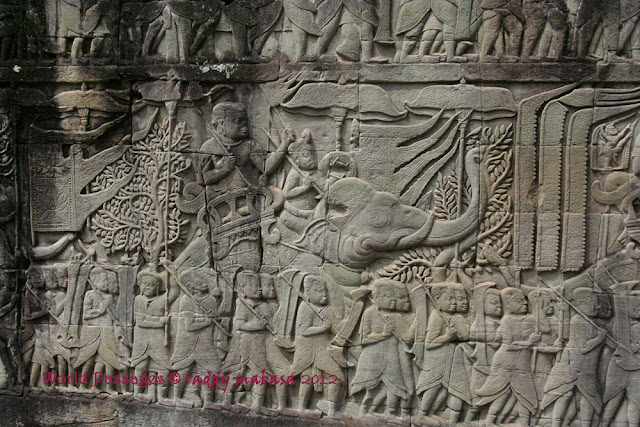A couple of kilometers to the north and more than four times the size of Angkor Wat is the last Great City of the Khmer Empire, Angkor Thom. Our destination for today is The Bayon, a temple at the heart of this massive complex.
Getting there would entail crossing a bridge and passing through a gate. As with Angkor Wat, a moat also surrounds the area although at present less than half is still filled with water. On each side of the bridge sits stone carved figures that are supposed to represent deities and demons. Our guide Vana told us which was which but I still get confused. The gate entrance has a very high arch because back in the day it was elephants with passengers on their backs that passed underneath and not cars.
If you get to look closely at the actual statue, chances are that you will see bullet holes. During the reign of the Khmer Rouge, soldiers used them for target practice.
Moving along and past the gate, we travelled along a dirt road lined on both sides with trees. Occasionally a monkey would pop out and try to approach some vehicles looking for a hand out.
As we neared the outer perimeter of the Bayon, we had to get out and walk. This is when locals will come near you and try to sell books, trinkets, and other souvenirs. It is also here that you get your first view of the giant heads in the distance. I couldn't help myself and decided to sneak a peek with the aid of my camera's zoom lens.
You know you have reached The Bayon when you see this sign...
Unlike Angkor Wat which is predominantly Hindu, The Bayon is Buddhist in nature. This standing statue of the King, being restored with help from the French, stands near the entrance. King Jayavarman VII, who was responsible for the construction of this temple was a devout Buddhist.
These ancient columns could be found at the perimeter wall before you enter.
As you go past the columns you find yourself against a stone wall that has intricate carvings that seek to describe how life was during the late 12th century.
The carving below is supposed to represent the king atop an elephant accompanied by his soldiers. Even the king back then had a driver. In other panels, one can distinguish Khmer, Oriental and what looks to be African Soldiers.
In this photo we see a very mundane activity that was hard for me to believe was practiced so long ago...cock fights!
They also had communal kitchens that prepared meals for the whole community. We see what looks to be a pig being cooked, rice being boiled, and skewered meats being grilled.
As you walk around the inner parts of the complex, you see so many serene smiling faces that seem to contemplate a content and happy life. There are in fact 216 of them all over The Bayon ("That" I remember).
After getting our fill of the place, we felt it was time to fill our tummies and we made our way out of the area. This is what you will see as you turn around and take one last look...
Over a nice relaxed lunch, we talked about how little we know about our world and how much there was to learn. Sooner or later talk of the Khmer Rouge came up and how we knew next to nothing of the atrocities they committed all in the name of misguided nationalism.
Led by Pol Pot, the Khmer Rouge ruled from 1975 - 1979. During this reign of terror, they drove everyone out of the cities and tried to exterminate what they perceived as the intelligentsia. Khmer Rouge guerrillas carried out mass executions and killed professionals and educators. They killed someone for wearing glasses because in their twisted mind wearing glasses meant that a person was educated and he was the enemy of the state.
People died of starvation or disease, families were forced to separate, women were raped, and there was very little the population could do to fight back. We take our liberties for granted these days and stories like these make us appreciate our living conditions more. I've asked a few locals about this part of their history but most would rather not talk about it. Vana, our guide, said that it's not that they choose to ignore their past but that they would rather move on. These events happened less than 50 years ago and there are still people around who lived through this dark time in their history.
International studies estimate that between 1.4 to 2.2 million were killed in that period of less than 5 years. In that short time, roughly 20-25% of the population was exterminated for no rhyme or reason.
Sorry about sneaking in the sobering history lesson, but I have always believed that learning about a country isn't only about visiting the touristy places, shopping or lounging by the pool. I have always wanted to learn more about the history and culture of the country and the people I visit. This helps me to understand them better.
I am hoping that you will still join me for the last part of this series, There are still two very beautiful sights to see.

















Thanks for this beautiful view of Cambodia! It is a comfort that there are some things that even the Khmer Rouge couldn't destroy. Great essay, "Dancing in Cambodia" by Amitav Ghosh in Granta #44 back in 1993 gave me my first glimpse into this wonderful country and its past.
ReplyDelete